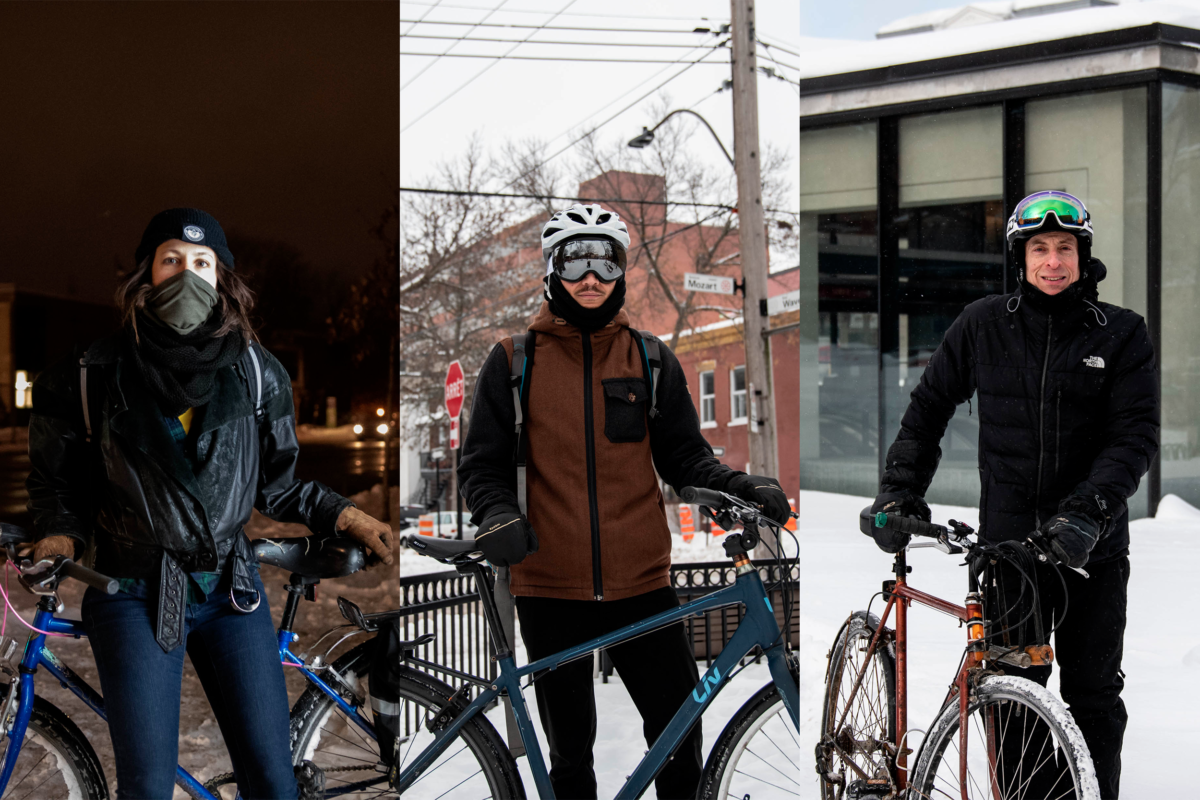A portrait of three winter cyclists who share the little-known facets of this underrated means of transportation in Montreal.
We all pass by them once in a while in the busy streets of Montreal. It does not matter whether we’re driving a car or getting off the bus — seeing them face the snow, the wind, and the cold always leaves us quite stunned. What can motivate these cyclists to pedal in sub-zero temperatures?
The Concordian spoke to cyclists Juan Pablo Lugo, Cynthia Venessa, and Mike Muchnik, detailing the experiences of these three daring cyclists.
Portrait of Juan Pablo Lugo. Photo by David J-B/THE CONCORDIAN
It was seeing his newly arrived friends from France start to practice winter cycling that pushed Lugo to start too. His first impression? It’s not that bad. There might be only a two-week span of time where it’s a bit harder.
“Most of the winter, it’s really practicable,” Lugo said.
He spoke about the surprising easiness of winter cycling. The cars go slower, biking paths are plowed, and physical effort keeps you warm. Provided you dress accordingly, it doesn’t seem to be that difficult to practice.
Portrait of Mike Muchnik. Photo by David J-B/THE CONCORDIAN
Muchnik is a winter cycling veteran. When he began to brave the cold more than a decade ago, biking paths were not as common in the then-car-dominated Montreal. Winter cycling was very marginal and the handful of daredevil cyclists of the time recognized each other in the busy streets of the city chatted at red lights and called themselves by their first names.
Today, Montreal markets itself as a bike-friendly city and now has a lengthy network of biking paths that are still being developed. But this mindset change did not appear magically. Instead, it gradually took place — thanks to many motivated cyclists like Muchnik.
Having no choice but to cross the Jacques-Cartier bridge to go to work, Muchnik faced the absurd closing of its biking path during winter. The stubborn administration of the time even went as far as contradicting its own studies which proved the bridge safe for cyclists.
But that didn’t stop him and a dozen other cyclists from crossing the bridge anyway in a show of civil disobedience, facing the only danger of a ticket. Then in 2017, with the help of the Coalition Mobilité Active Montréal and a few other cyclists, Muchnik founded the Association des piétons et cyclistes du pont Jacques-Cartier to pressure the administration into opening the cycling path.
After many public sorties, protests, debates, and discussions with representatives, the cycling path of the Jacques-Cartier bridge is now accessible during winter, although not all day. This policy change was a victory and concrete proof that environmental civilian mobilization can work. Behind physical progress for greener cities and more accessible active transports such as the Réseau Express Vélo are dozens of passionate and committed cyclists.
Portrait of Cynthia Venessa. Photo by David J-B/THE CONCORDIAN
Venessa is also a fervent adherent to winter cycling. To get started, she recommends gradually pushing back the moment when you would have normally put aside your bicycle. What motivates her? The feeling of freedom and autonomy from being able to cycle whenever, wherever without having to rely on public transit.
Another facet of winter cycling that surprised me was the unexpected enthusiasm of the cyclists spoken to. Cycling in the winter looks fun. It’s healthy, faster, ecological, and very active.
This example of community organization also reveals the fabulous community of winter cyclists in the city. The Facebook page Vélo d’hiver – Montréal gathers 16 thousand followers and is very prolific in its content. The topics of equipment, cycling paths, and different challenges the cyclists encounter on a daily basis are discussed in a friendly and positive atmosphere.
Winter cycling is not only possible and accessible, but it can also be fun and easy.
